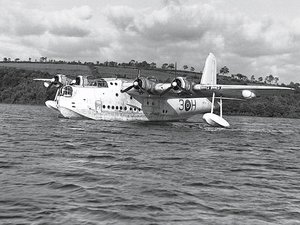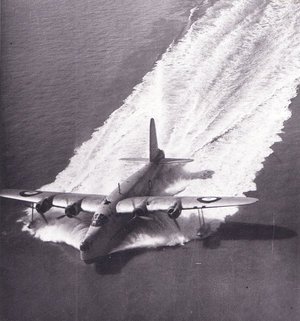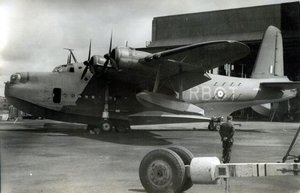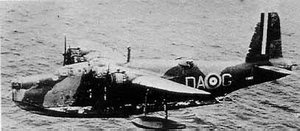Short Sunderland
|
|
| Short Sunderland | ||
|---|---|---|
 A Sunderland in the water | ||
| Description | ||
| Role | Maritime patrol | |
| Crew | ||
| Dimensions | ||
| Length | 85 ft 3.5 in | 26.0 m |
| Wingspan | 112 ft 9.5 in | 34.4 m |
| Height | 34 ft 6 in | 10.5 m |
| Weights | ||
| Empty | 36,900 lb | 16,700 kg |
| Loaded | 60,000 lb | 27,200 kg |
| Powerplant | ||
| Engines | 4 x Bristol Pegasus X, XVIII or Hercules XVII | |
| Power | hp | kW |
| Performance | ||
| Maximum Speed | 213 mph at 5,000 ft | 343 km/h at 1,500 m |
The Sunderland, S.25, was a flying boat patrol bomber, developed for the Royal Air Force by Short Brothers, based on their successful S.23 Empire flying boats, the flagship of Imperial Airways. The Sunderland first flew on October 16, 1937, and became one of the most powerful and widely used patrol bombers during World War II, terror of the German U-boat fleet.
| Contents [hide] |
History of the Sunderland
In the early 1930s, competition in development of long-range flying boats for intercontinental passenger service was becoming increasingly intense. The United Kingdom had nothing to match the new American Sikorsky flying boats that were making headlines all over the world, and the powers-that-be in Britain felt something should be done.
In 1934, the British postmaster general declared that all first-class Royal Mail sent overseas was to travel by air, effectively establishing a subsidy for the development of intercontinental air transportation in a fashion similar to the US's domestic program of a decade earlier. In response, British Imperial Airways announced a competition for 28 flying boats, each weighing 16.4 tonnes (18 tons) and having a range of 1,130 km (700 miles) with a capacity of 24 passengers.
The contract went almost directly to Short Brothers of Rochester in England. Short had long experience in building flying boats for the military and for Imperial Airways. However, none of these flying boats were in the class of size and sophistication requested. The business opportunity was too great to pass up despite the risk, and so Oswald Short, head of the company, began a crash program to come up with a design for a flying boat far beyond anything they had ever built.
While the first S.23 was under development, the British military was taking actions that would result in a purely military version of the big Shorts flying boats. A 1933 British Air Ministry requirement designated "R.2/33" called for a next-generation flying boat for ocean reconnaissance. The new flying boat was to have four engines, but could be either a monoplane or biplane design.
The R.2/33 specification was released roughly in parallel with the Imperial Airways requirement, and while Shorts worked on the S.23 they also worked on a response to the Air Ministry's need at a lower priority. The military flying boat variant was designated S.25, and the design was submitted to the Air Ministry in 1934. Saunders-Roe also designed a flying boat designated the "A.33" for the R.2/33 competition. The military ordered prototypes of both the S.25 and S.33 for evaluation.
Basic design
The S.25 shared much in common with the S.23, and was most notably different in that it had a deeper hull profile. As with the S.23, the Sunderland's fuselage contained two decks, containing six bunks, a galley with a stove, a shore-type porcelain flush toilet, and a small machine shop for in-flight repairs. The crew was originally intended to be seven, but the number of crew would increase in later versions to eleven or more.
The aircraft was of metal construction, except for most of the control surfaces, which had metal frames and were covered by fabric. Although the Sunderland was not an amphibian, beaching gear allowed it to be pulled up on land. Two-wheeled struts could be attached to either side of the fuselage, while a small two-wheel trolley with a tow bar could be fitted under the rear of the hull.
The thick wings carried the four Pegasus XXII engines and accommodated six drum fuel tanks with a total capacity of 9,200 l (2,025 Imperial gallons, 2,430 US gallons). Four more fuel tanks would later be added behind the rear wing spar to give a total fuel capacity of 11,602 l (2,550 Imperial gallons, 3,037 US gallons).
Offensive armament load was a 37mm gun in the extreme nose, and up to 2,000 pounds (900 kg) of bombs, mines, or (eventually) depth charges. Ordnance was carried inside the fuselage, and since it would be unwise to cut a hole in the boat hull, it had to be winched out under the wings through doors on each side of the fuselage. Defensive guns included a Fraser Nash FN.13 powered turret with four .303 in (7.7 mm) guns in the extreme tail, and a manually operated .303 on either side of the fuselage, firing from ports just above and behind the wings.
Prototype
The first S.25, now named the Sunderland Mark I, flew from the River Medway on 16 October 1937. The deeper hull and installation of nose and tail turrets gave the Sunderland a considerably different appearance from the Empire flying boats. The prototype was fitted with Bristol Pegasus X engines, each providing 709 kW (950 hp), as the planned Pegasus XXII engines with 753 kW (1,010 hp) each were not available at the time.
The 37 mm gun, originally intended as a primary anti-submarine weapon, was dropped from the plans during the prototype phase and replaced with a FN.11 nose turret mounting a single .303 machine (7.7 mm) gun. The turret could be winched back from the nose, revealing a small "deck" used for mooring manouevres on the water. The change of armament in the nose to the much lighter gun resulted in a rearward shift in center of gravity.
After the first flight the aircraft was returned to the shop, and a modified wing was installed that was swept 4.5 degrees to the rear, thereby moving the center of pressure into a more reasonable position compared to the new CoG. This left the engines and wing floats canted out from the aircraft's centerline. Although the wing loading was much higher than that of any previous RAF flying boat, a new flap system kept the takeoff run to reasonable length. It flew again with the new wing and the uprated Pegasus XXII engines on March 7 1938.
Official enthusiasm for the type was so great that in March 1936, even before the first flight of the Sunderland prototype, the Air Ministry had ordered 21 production examples. Meanwhile, delivery of the SaRo A.33 was delayed and did not fly until October 1938. The aircraft was written off after it suffered a structural failure during high-speed taxi trials, and no other prototypes were built.
Sunderland Mark I
The RAF received its first Sunderland Mark I in June 1938, when the second production aircraft was flown to Singapore. By the outbreak of war in Europe in September 1939, the RAF Coastal Command was operating 40 Sunderlands.
Although British antisubmarine efforts were disorganized and ineffectual at first, Sunderlands quickly proved useful in the rescue of crews of torpedoed ships. On 21 September 1939, two Sunderlands rescued the entire 34 man crew of the torpedoed merchantman Kensington Court from the North Sea. As British antisubmarine measures improved, the Sunderland began to show its claws as well. A Royal Australian Air Force (RAAF) Sunderland performed the type's first unassisted kill of a U-boat on 17 July 1940.
As the British honed their combat skills, the Sunderland Mark I received various improvements to make it more effective. The nose turret was upgraded to two .303 (7.7 mm) guns instead of one. New propellers and pneumatic rubber wing deicing boots were fitted as well.
Although the .303 guns lacked range and hitting power, and the British would presently understand the need for more formidable weapons, the Sunderland had a fair number of them, and it was a well-built machine that was hard to destroy. On 3 April 1940, a Sunderland operating off Norway was attacked by six German Junkers Ju 88 fighters, and managed to shoot one down, damage another enough to send it off to a forced landing, and drive off the rest. The Germans were supposed to have nicknamed the Sunderland the "Fliegende Stachelschweine" (Flying Porcupine).
Sunderlands also proved themselves in the Mediterranean theater. They performed valiantly in performing evacuations during the German seizure of Crete, and one performed a reconnaissance mission to observe the Italian fleet at anchor in Taranto before the famous Royal Navy Fleet Air Arm's torpedo attack on 11 November 1940, the Battle of Taranto.
Beginning in October 1941, Sunderlands were fitted with ASV Mark II radar (Anti-Surface Vessel). This was a primitive low-frequency radar system operating at a wavelength of 1.5 m, featuring a row of four prominent "stickleback" yagi antennas on top of the rear fuselage, two rows of four smaller aerials on either side of the fuselage beneath the stickleback antennas, and a single receiving aerial mounted under each wing outboard of the float and angled outward.
A total of 75 Sunderland Mark Is were built, produced at Shorts factories at Rochester, England and Belfast, Northern Ireland, as well as 15 of the 75 built by Blackburn Aircraft at Dumbarton.
Sunderland Mark II
In August 1941, production moved to the Sunderland Mark II, which featured Pegasus XVIII engines with two-speed superchargers and provided 794 kW (1,065 hp) each.
The tail turret was changed to an FN.4A turret that retained the four .303 (7.7 mm) guns of its predecessor, but provided twice the ammunition capacity, with a total of 1,000 rounds per gun. Late production Mark IIs also had a FN.7 dorsal turret, mounted offset to the right just behind the wings, and fitted with twin .303 (7.7 mm) machine guns. The hand-held guns behind the wing were removed in these versions.
Only 43 Mark IIs were built, with 5 of the 43 manufactured by Blackburn.
Sunderland Mark III
Production quickly went on in December 1941 to the Sunderland Mark III. This variant featured a revised hull configuration, tested on a Mark I the previous June, that provided improved seaworthiness, which had suffered as the weight of the Sunderland increased with new marks and field changes. In earlier Sunderlands, the hull "step" that allowed a flying boat to "unstick" from the surface of the sea was abrupt, but in the Mk III it was a smooth curve.
The Mark III would turn out to be the definitive Sunderland variant, with a total of 461 built. Most were built by Shorts at Rochester, Belfast, and a new plant at Lake Windemere, but 170 of the total were built by Blackburn. The Sunderland Mark III would prove to be one of the RAF Coastal Command's major weapons against the U-boats, along with the Consolidated PBY Catalina.
Sund3.jpg
New weapons made the flying boats more deadly in combat. The ineffectual anti-submarine bombs, which in some cases were known to bounce up and hit their launch aircraft, were replaced by early 1943 by much more effective Torpex depth charges that would sink to a shallow depth and then explode. This not only eliminated the problem of bounce-back, but the shock wave propagating through the water had greater effect.
Although the bright Leigh searchlight was rarely fitted to Sunderlands, ASV Mark II radar allowed the flying boats to effectively target U-boats operating on the surface. In response the German submarines began to carry a radar warning system known as "Metox", also known as the Cross of Biscay due to the appearance of its receiving antenna, which was tuned to the ASV frequency and gave the submarines early warning that an aircraft was in the area. Kills fell off drastically until ASV Mark III radar was introduced in early 1943, which operated in th centimetric band and used antennas mounted in blisters under the wings outboard of the floats, instead of the cluttered stickleback aerials. Sunderland Mark IIIs fitted with ASV Mark III were designated Sunderland Mark IIIAs.
Centimetric radar was invisible to Metox and completely baffled the Germans at first. Admiral Karl Dönitz, commander of the German U-boat force, suspected at first that the British were being informed of submarine movements by spies. There is a story that a British prisoner, a smooth liar, confused them by saying the aircraft were homing in on the Cross of Biscay.
In any case, the Germans responded by fitting U-boats with one or two 37mm and twin quad 20mm flak guns to shoot it out with the attackers. While Sunderlands could suppress flak to an extent by hosing down the U-boat with their nose-turret guns, the U-boats had the edge by far in range and hitting power. To help improve the odds somewhat, many Sunderlands were fitted in the field with an additional four .303's in fixed mounts in the nose, allowing the pilot to add fire while diving on the submarine before bomb release. Additions of 50 caliber (12.5mm) machine guns in the previously emptied side gun mounts also became common.
The rifle-caliber .303 guns were far from satisfactory as they lacked hitting power, but the Sunderland retained its reputation for being able to take care of itself. This reputation was enhanced by a savage air battle between eight Ju 88C long-range heavy fighters and a single RAAF Sunderland Mark III on June 2 1943. There were eleven crewmen on board the Sunderland, including nine Australians and two British. The crew was on an antisubmarine patrol and also searching for remains of an airliner that had left Gibraltar the day before, to be shot down over the Bay of Biscay with the loss of all crew and passengers, including British film star Leslie Howard, known for his starring role in The Scarlet Pimpernel and supporting work in Gone with the Wind.
In the late afternoon, one of the crew spotted the eight Ju 88s. Bombs and depth charges were dumped while Walker redlined the engines. Two Ju 88s made passes at the flying boat, one from each side, scoring hits while the Sunderland went through wild "corkscrew" evasive maneuvers. The fighters managed to knock out one engine. On the third pass of the fighters, the top-turret gunner managed to shoot one down. Another Ju 88 disabled the tail turret, but the next fighter that made a pass was bracketed by the top and nose turrets and shot down as well.
Still another fighter attacked, smashing the Sunderland's radio gear, wounding most of the crew in varying degrees and mortally wounding one of the side gunners. A Ju 88 tried to attack from the rear, but the tail turret gunner had managed to regain some control over the turret and shot down the German fighter. The surviving fighters pressed home their attacks, despite the losses. The nose gunner chewed up one of the fighters and set one of its engines on fire. Two more of the attackers were thoroughly shot up, and the other two finally decided they'd had enough and departed. Luftwaffe records indicate these were the only two that made it back to base.
The Sunderland was a wreck. The crew threw everything they could overboard and nursed the aircraft back to the Cornish coast, where Walker managed to land and beach it. The crew waded ashore, carrying their dead comrade, while the surf broke up the Sunderland. The pilot, Walker, received the Distinguished Service Order, and several of the other crew received medals as well. Walker went on to a ground job, while the rest of the crew were given a new Sunderland. That Sunderland and its crew disappeared without a trace over the Bay of Biscay two months later, after reporting by radio that they were under attack by six Ju 88s.
Sunderland Mark IV (S.45 Seaford)
Short_s45_seaford.jpg
Although a Sunderland Mark IV was developed, it proved to be different enough from the Sunderland line to be given a different name, and did not see combat in any case. The Sunderland Mark IV, was an outgrowth of a 1942 Air Ministry specification, "R.8/42", for a generally improved Sunderland with more powerful Bristol Hercules engines, better defensive armament, and other enhancements. The new Sunderland was intended for service in the Pacific.
Relative to the Mark III, the Mark IV had a stronger wing, bigger tailplanes, and a longer fuselage with some changes in form. The armament was greatly improved, consisting of two fixed forward-firing 50 caliber (12.7 mm) guns in the nose, a Brockhouse nose turret with twin 50 cal (12.7 mm) machine guns, twin 20 mm Hispano cannon mounted in a B-17 dorsal turret, twin 50 cal (12.7 mm) guns in a Martin tail turret, and another 50 cal (12.7 mm) machine gun in a hand-held position on each side of the fuselage,
The changes were so substantial that the new aircraft was redesignated the S.45 Seaford. Two prototypes and thirty production examples were ordered, and the first prototype flew in April 1945, well after the introduction of the Sunderland IV, and too late to see combat. The prototypes were powered by Hercules XVII engines with 1,253 kW (1,680 hp), but production aircraft used Hercules XIXs with 1,283 kW (1,720 hp). Only eight production Seafords were completed, and never got beyond operational trials with the RAF.
The second production Seaford was loaned to BOAC in 1946 for evaluation as a civil airliner. BOAC liked the aircraft, and so 12 Seafords then being laid down were completed as Solent Mark 2. Most of the RAF Seafords were rebuilt as Solent Mark IIIs.
Sunderland Mark V
The next actual production version was the Sunderland Mark V, which evolved out of crew concerns over the lack of power of the Pegasus engines. The weight creep that afflicted the Sunderland resulted in running the Pegasus engines on combat power as a normal procedure, and the overburdened engines had to be replaced on a regular basis.
Australian Sunderland crews suggested that the Pegasus engines be replaced by Pratt & Whitney R-1830-9OB Twin Wasp engines. The 14-cylinder engines provided 895 kW (1,200 HP) each and were in use on RAF Consolidated Catalinas and Douglas Dakotas, making logistics and maintenance straightforward.
Two Mark IIIs were taken off the production lines in early 1944 and fitted with the American engines. Trials were conducted in early 1944, and the conversion proved all that was expected. The new engines provided greater performance with no real penalty in range. In particular, a Twin Wasp Sunderland could stay airborne if two engines were knocked out on the same wing, while a standard Mark III would steadily lose altitude.
Production was converted to the Twin Wasp, and the first Mark V reached operational units in February 1945. Defensive armament fits were similar to those of the Mark III, but the Mark V was equipped with new centimetric ASV Mark VIC radar, which had been used on some of the last production Mark IIIs as well.
155 Sunderland Mark Vs were built, and another 33 Mark IIIs were converted to Mark V specification. With the end of the war, large contracts for the Sunderland were cancelled, and the last of these great flying boats was delivered in June 1946, with total production of 749 aircraft.
At the time, a number of new Sunderlands built at Belfast were simply taken out to sea and scuttled, as there was nothing else to do with them. However, despite this indignity, there was plenty of life left in the Sunderland. In Europe, the Sunderland was removed from service relatively quickly. However, in the Far East, where well-developed runways were less common, meaning that large land-based maritime patrol aircraft like the new Avro Shackleton could not be used so easily, there was still a need for the Sunderland. It remained in service with the Far East Air Force at Singapore until 1959, and with the Royal New Zealand Air Force until 1967.
Reference
The initial version of this article was based on a public domain article from Greg Goebel's Vectorsite.
External links
- Fighting the U-boats: Short Sunderland (http://uboat.net/allies/aircraft/sunderland.htm)
- Short Sunderland (http://users.chariot.net.au/~theburfs/sunderMAIN.html)
|
Lists of Aircraft | Aircraft manufacturers | Aircraft engines | Aircraft engine manufacturers Airports | Airlines | Air forces | Aircraft weapons | Missiles | Timeline of aviation |



